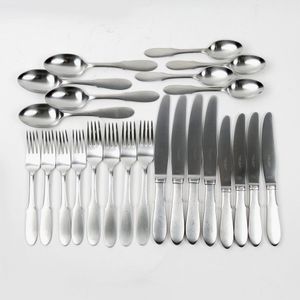Rare Sterling Silver Old English Flatware by Harry Fischer
You must be a subscriber, and be logged in to view price and dealer details.
Subscribe Now to view actual auction price for this item
When you subscribe, you have the option of setting the currency in which to display prices to $Au, $US, $NZ or Stg.
- Old English Pattern - The Old English pattern as is commonly seen on silver flatware is characterized by a simple, clean shape with a slightly upturned tip and a broad handle that tapers gently towards the bowl or blade. The handle may be plain or decorated with a subtle design, such as a line or ridge along the edge or a small decorative motif at the tip. This pattern was first introduced in the 18th century and has remained popular ever since, making it a popular choice for traditional and formal table settings.
- Flatware - An alternative name for items of cutlery, principally knives, forks and spoons, now generally used to describe sets of these implements. Nowadays it is mostly used when describing cutlery made of silver and silver plate.
It is less frequently used to describe all "flat' items of tableware, so that as well as cutlery the definition includes plates. - Sterling Silver - Sterling silver is a mixture of 92.5% pure silver and 7.5% of another metal, usually copper. Fine silver is 99.9% pure silver, and is relatively soft and the addition of the very small amount of copper gives the metal enough strength and hardness to be worked into jewellery, decorative and household objects.
- Circa - A Latin term meaning 'about', often used in the antique trade to give an approximate date for the piece, usually considered to be five years on either side of the circa year. Thus, circa 1900 means the piece was made about 1900, probably between 1895 and 1905. The expression is sometimes abbreviated to c.1900.
This item has been included into following indexes:
Visually similar items

English hallmarked sterling silver Victorian set of twelve coffee spoons having reeded & floral rosette detail. Sheffield, 1895, maker Lee & Wigfull, weight 136.5g

Seventeen austro Hungarian Empire antique silver tea/ coffee and demitasse spoons, marked Minerva, finesse 800 C1867-1922, mixed makers marks approx 12 cm long and smaller, 264g

A Georg Jensen 'Acorn' pattern flatware service designed by Johan Rohde, post 1945 marks, (190), comprising, eight dinner knives, eight luncheon knives, eight fruit knives, eight dinner forks, eight luncheon forks, eight pastry forks, eight soup spoons, ei

A four piece Georg Jensen brushed steel cutlery set, dinner and luncheon knives, forks and spoons in the Mitre Canute pattern designed in 1941 for Georg Jensen.
